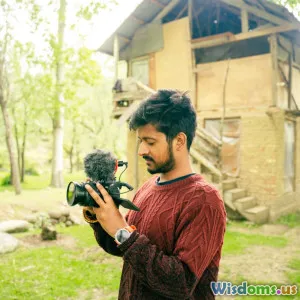
Exploring Cloud Technology's Impact on Film Production
8 min read Discover how cloud technology revolutionizes film production with efficiency, collaboration, and creativity. (0 Reviews)
Exploring Cloud Technology's Impact on Film Production
In recent years, cloud technology has revolutionized many industries, and film production is no exception. Traditionally, film making involved bulky physical equipment, localized data storage, and limited collaboration options. But today, cloud computing is rewriting the playbook—enabling filmmakers to tap into unprecedented computational power, seamless collaboration across continents, and nimble production workflows. This article dives deep into how cloud technology is transforming film production by enhancing creativity, boosting efficiency, and reshaping the entire filmmaking ecosystem.
Breaking Geographical Barriers: Remote Collaboration in Film Production
One of the greatest challenges in traditional filmmaking has been the geographically dispersed nature of project teams. Directors, editors, sound engineers, VFX artists, and producers often work from different locations, making real-time collaboration cumbersome and slow.
Cloud platforms such as AWS Cloud, Google Cloud, and Microsoft Azure offer virtual workspaces where creatives can collaborate synchronously or asynchronously. For example, Netflix's Open Connect system leverages cloud infrastructure to streamline content delivery and post-production workflows globally. By uploading dailies or project footage to the cloud, editors and VFX teams across the world can simultaneously access and work on the exact same assets.
Real-time collaboration saves critical time during tight production schedules. Software like Frame.io now integrates with major cloud providers to allow instant review, annotations, and feedback sharing. A VFX artist in Mumbai can immediately communicate complex effects tweaks with a director in Los Angeles without shipping physical drives or dealing with latency.
Scalable Storage Solutions: Tackling the Data Deluge
High-resolution film footage comes with monumental storage demands. A feature film shot in 8K resolution can generate terabytes of raw footage even before editing begins. Traditional on-premises storage systems are costly, hard to scale, and prone to damage or loss.
Cloud storage solutions like Amazon S3, Google Cloud Storage, and Azure Blob Storage provide virtually unlimited, cost-effective, and secure repositories for film data. Studios can dynamically pay for what they use, eliminating upfront capital expenditure. Moreover, advanced redundancy and backup policies help safeguard precious footage against disasters.
The case of International Film Festival Circuit participant 'Sirava' highlights this well: after switching to a hybrid cloud storage model, their media asset retrieval time improved by over 40%, accelerating editing and review processes. Additionally, the cloud allows teams to implement sophisticated metadata tagging and AI-powered search capabilities, making it easy to locate specific shots or takes among thousands.
Accelerating Post-Production with Cloud Computing
Post-production—the phase involving editing, color grading, sound mixing, and visual effects—is often the most resource-intensive stage of filmmaking. It requires massive computing power, specialized software, and skilled operators.
Cloud computing equips studios with on-demand access to high-performance virtual machines, GPUs, and rendering farms that can be scaled according to workload. This flexibility drastically reduces rendering times—from days to hours—and enables creators to experiment with complex visual effects without worrying about terminal hardware limitations.
Companies like Technicolor have partnered with cloud providers to offer remote color grading and VFX services, allowing artists to work securely from anywhere. Cloud-based editing software such as Adobe Premiere Pro with Team Projects or Blackmagic Design’s DaVinci Resolve Studio now integrate cloud storage and collaboration features, streamlining post workflows.
Furthermore, cloud platforms increasingly harness AI and machine learning. Automated scene detection, facial recognition for casting, and smart audio cleanup tools are becoming commonplace, helping post-production teams maintain high quality while accelerating output.
Democratizing Film Production: Lowering Barriers for Indie Creators
Cloud technology doesn't just benefit big studios—it empowers independent filmmakers and startups by leveling the technological playing field.
Previously, access to high-end production tools and infrastructure was a privilege of major companies due to costs and complexity. But now, affordable monthly subscriptions for cloud-based software and storage enable indie creators to harness top-tier capabilities without heavy investment.
Platforms like Frame.io and Wipster facilitate professional review and approval cycles without physical meetings. Cloud-rendering services such as RebusFarm help animators and VFX artists affordably outsource rendering jobs. This democratization fosters more diversity in storytelling and innovation.
Challenges and Considerations
Despite clear benefits, incorporating cloud solutions also comes with challenges. Security of intellectual property remains paramount for producers wary of leaks. Maintaining data privacy through stringent encryption, access controls, and audits is crucial.
Bandwidth constraints in some regions can slow large file transfers, requiring hybrid approaches that mix local and cloud storage. Additionally, cloud costs can grow unpredictably if not carefully managed based on data egress and compute usage.
Yet, as technology matures and providers tailor offerings for media industries, many of these challenges are actively addressed through innovations such as edge computing, private cloud instances, and AI-driven cost optimizations.
Conclusion: An Irreversible Shift Towards the Cloud
Cloud technology is no longer an emerging trend but a foundational transformation in film production. By enabling seamless collaboration, scalable storage, accelerated post-production, and equitable access to high-end tools, cloud computing unlocks creative and operational potential previously impossible.
Today's filmmakers stand at a crossroads where embracing cloud solutions offers sharper competitive advantage, reacts better to unpredictable global circumstances (as seen during the pandemic), and drives the future of storytelling.
In the ever-evolving filmmaking landscape, cloud technology fuels the artistic ambition of creating compelling stories that resonate worldwide—while reinventing how those stories come to life behind the scenes.
References & further reading:
- AWS Media Solutions: https://aws.amazon.com/media/
- Netflix Open Connect: https://openconnect.netflix.com/
- ‘‘Sirava’ Film Festival Case Study’ (2022)
- Frame.io and Adobe Team Projects Integration: https://blog.frame.io/
- Technicolor Cloud Studio Services: https://www.technicolor.com/solutions/cloud/
- RebusFarm Rendering: https://us.rebusfarm.net/
Quote:
"Cloud technology isn’t just a tool; it’s a creative revolution amplifying the filmmaker’s vision globally." – Film Industry Analyst
Rate the Post
User Reviews
Popular Posts




















